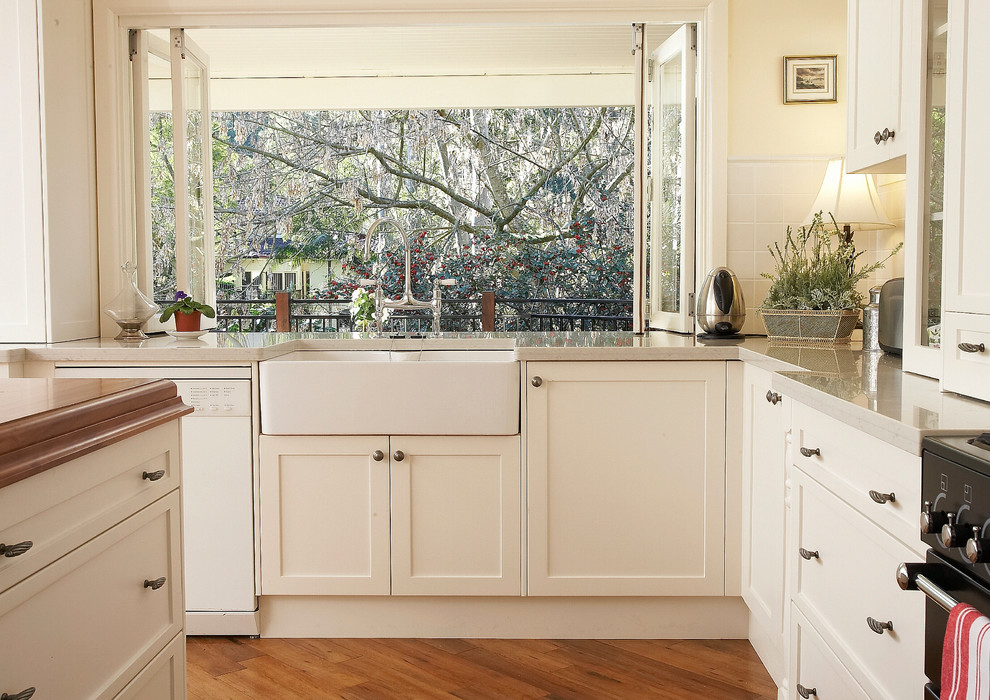
Everything You Need to Know About Farmhouse Sinks
I hold a special fondness for the charming Belfast farmhouse sink, a quintessential feature in traditional country and farmhouse kitchen designs. These sinks harken back to a time devoid of running water, where water was manually fetched from nearby wells, lakes, or rivers.
The farmhouse sink concept emerged in the late 17th century in Ireland and Britain, spawning two distinctive variations: the Belfast sink and the London sink. The Belfast sink boasted a deep basin with an overflow mechanism, facilitating easy drainage of excess water. In contrast, the London sink, designed for regions with water scarcity, featured a shallower basin without an overflow, ensuring not a drop of precious water was wasted.
For those contemplating a farmhouse-style sink for their kitchen, here’s a comprehensive guide to consider.
The traditional farmhouse sink distinguishes itself by its considerable depth compared to modern stainless steel undermount or top-mount sinks. Its design allows users to stand directly in front of the basin without any intervening cabinets or countertops. This characteristic was particularly advantageous in earlier times when women spent substantial portions of their day at the sink, performing tasks ranging from food preparation to washing dishes, clothes, and even infants.
While today’s farmhouse sinks still accommodate bathing infants, their primary utility lies in handling large items such as pots, baking sheets, oven trays, and even barbecue grills—items that would typically pose challenges in a standard sink.
For those seeking additional functionality, double-bowl options like the one depicted here offer enhanced versatility.
Installation
Originally crafted to protrude slightly in front of the surrounding cabinets, farmhouse sinks were ingeniously designed to channel any water cascading down the front directly to the floor, thus safeguarding the cabinets from potential damage—a characteristic retained in their typical installation today.
Moreover, these sinks are commonly positioned just below the countertop level, facilitating a slight overhang of the counter edges over the sink. This thoughtful configuration simplifies the task of wiping water from the counter, allowing it to seamlessly flow into the sink.
Drainage
Having a designated area on the counter for draining freshly washed dishes is an added convenience. In this setup, shallow channels, referred to as drainer grooves, are intricately routed into the countertop. These grooves gradually deepen as they approach the sink, facilitating the smooth flow of drained water directly into the sink basin. This ingenious design not only enhances functionality but also preserves the aesthetic appeal of the farmhouse sink, seamlessly integrating practicality with style.
Fixtures
Incorporating a farmhouse sink into your kitchen design evokes a nostalgic ambiance and infuses a rustic charm that complements country- and traditional-style kitchens. To achieve a cohesive aesthetic, consider pairing your white porcelain farmhouse sink with a traditional-style faucet, often featuring matching white porcelain handles for a cohesive look. Given that typical farmhouse sinks lack pre-drilled faucet holes, positioning the tap either on the countertop or on the wall behind becomes necessary to complete the ensemble.
Materials
White farmhouse sinks are predominantly crafted from either fireclay or porcelain.
Fireclay: Constructed from clay heated to exceptionally high temperatures, fireclay sinks boast remarkable durability and a lustrous finish. Their resilience renders them resistant to scratches and chips, ensuring easy maintenance.
Porcelain: Comprising ceramic material subjected to high temperatures, though slightly lower than fireclay, porcelain sinks offer a similar aesthetic to fireclay at a lower cost. However, they are comparatively less durable, prone to chipping and discoloration over time.
Stainless Steel: Farmhouse sinks now come in a broader range of materials, including stainless steel. Stainless steel offers affordability, durability, and effortless maintenance. Its inclusion provides a contemporary touch to a sink traditionally associated with country- and traditional-style kitchens.
Copper: Some farmhouse sinks are crafted from copper, often featuring a hammered finish and applied colored patina during manufacturing. With time, natural oxidation processes result in a stunning patina formation, enhancing the sink’s aesthetic appeal as it interacts with various substances.
Modern Style
Redesigned versions of the farmhouse sink, like the one depicted here, offer a contemporary twist. Unlike the traditional farmhouse sink, this iteration sits atop the countertop and features an integrated tap hole, eliminating the necessity for a countertop extension behind it. By resting on the counter surface, this design mitigates the risk of water seeping down the sides of the sink, resulting in a more watertight but less authentic option.
Considerations
Seal: Fireclay and porcelain farmhouse sinks may exhibit slight variations in measurements and uneven surfaces, which are inherent traits of these materials and not indicative of flaws. Consequently, when installed beneath a perfectly level countertop, minor gaps may occur, allowing water to escape. To address this, it’s crucial to properly seal the farmhouse sink around its edges post-installation. Additionally, designing the countertop with sufficient overhang ensures that water flows directly into the sink bowl, preventing it from pooling around the edges.
Design: While integrating a farmhouse sink into a new kitchen layout is straightforward, it can pose challenges when adding to an existing setup. The size and unique characteristics of farmhouse sinks often necessitate custom cabinet designs and alterations to the countertop layout. Consulting with your cabinetmaker is advisable to explore options for modifying existing cabinets and countertops to accommodate the farmhouse sink seamlessly.
Surface: While pristine white porcelain sinks boast a stunning appearance, they are prone to revealing every speck of dirt and grime. Nonetheless, they are relatively easy to clean.
The hard surface of fireclay or porcelain farmhouse sinks can amplify noise during dishwashing and is less forgiving than stainless steel when handling breakable items. Exercise caution, particularly when washing delicate glassware.
Size: If water conservation is a concern, consider opting for a farmhouse sink with a smaller capacity. While the generous depth of traditional farmhouse sinks accommodates large items for washing, it also requires a considerable amount of water to fill compared to standard sinks.
Conclusion
While farmhouse sinks exude timeless charm and practicality in kitchen design, their selection requires careful consideration of various factors such as material, design, and size. Whether opting for classic porcelain or modern stainless steel, understanding the nuances of each material and considering individual lifestyle needs ensures a seamless integration into the kitchen space. Additionally, addressing potential challenges like maintenance and water usage enables homeowners to fully appreciate the aesthetic and functional benefits that farmhouse sinks bring to any culinary environment.



